Few elements can match the charm and practicality of a well-designed walkway, guiding guests while boosting your home’s curb appeal. Whether leading to your front door, garden, or backyard, a thoughtfully planned path adds structure, safety, and style to any outdoor space. With countless materials and design options available, finding solutions that reflect both personality and function has never been more accessible. This collection of DIY walkway ideas is tailored to help you make informed, lasting choices that fit your space and budget. Keep reading to uncover inspiring ways to enhance your landscape with paths built to impress and endure.
Hidden Lighting Stone Borders
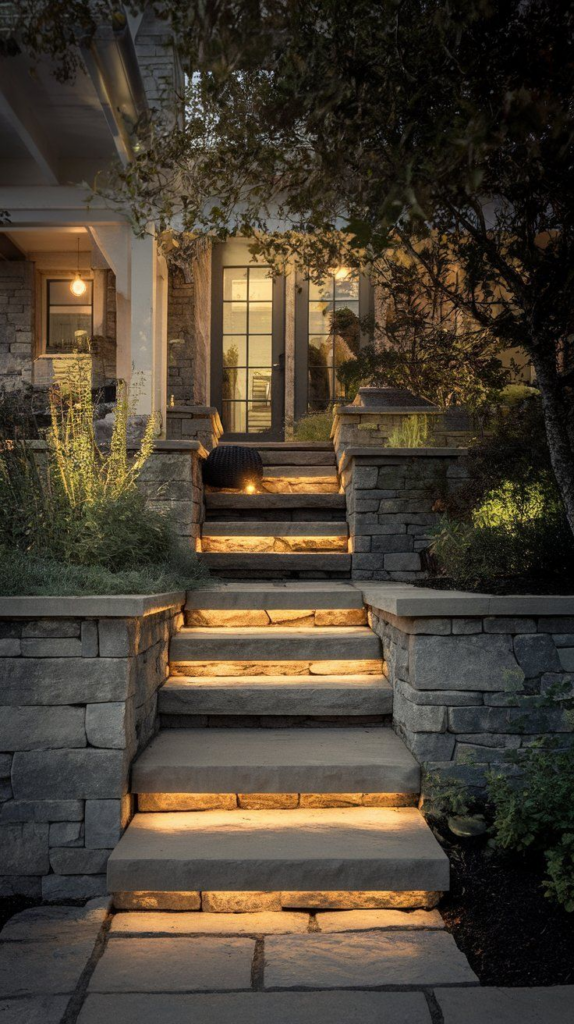
Subtle illumination woven into stone borders can significantly extend the usability of outdoor walkways while enhancing safety after dusk. Strategically placed LED strips or recessed spotlights within the edging create a low-profile glow that outlines paths without overpowering the natural landscape. Selecting durable, weather-resistant lighting ensures long-term performance, even through heavy rainfall or extreme temperatures. Opting for warm-toned bulbs provides a cozy atmosphere, harmonizing with natural stone textures and surrounding greenery.
Planning placement is essential. Ensure cables are discreetly buried beneath the soil and protected from moisture to avoid disruptions. Solar-powered options eliminate the need for extensive wiring, making installation more straightforward for DIY enthusiasts. Pairing lighting with irregular stone shapes adds character, guiding footsteps while accentuating the unique contours of the border.
Proper maintenance will keep the design looking its best. Clear debris regularly from light fixtures and check for any moisture buildup that could affect electrical components. Combining function with aesthetic appeal, hidden lighting within stone borders is a practical way to elevate outdoor walkways, ensuring they remain inviting and visible throughout the evening hours. With careful design choices, this feature effortlessly transforms standard paths into captivating, illuminated experiences.
Pivoting Stepping Slab Path

Dynamic pathways often rely on thoughtful design elements that adapt to varying outdoor spaces. Pivoting stepping slabs introduce flexibility, allowing users to reconfigure their walkway layout according to seasonal needs or aesthetic preferences. Unlike fixed pavers, these rotating slabs are mounted on discreet bases, granting each piece a smooth swivel motion for seamless adjustments.
Material selection plays a key role in durability and appearance. Opt for dense, non-slip surfaces like natural slate or textured concrete to withstand foot traffic while reducing the risk of slipping in wet conditions. Proper spacing between slabs encourages drainage, preventing water accumulation that can lead to erosion or mildew buildup.
Maintenance involves routinely checking the pivot mechanisms to ensure they remain secure and free from debris. Lubricating the joints can prolong functionality, preserving the path’s fluid motion over time. When combined with surrounding greenery or gravel infill, pivoting stepping slabs create an interactive, adaptable route that complements both structured gardens and relaxed outdoor retreats.
For homeowners seeking to merge versatility with a modern aesthetic, this pathway solution stands out as an innovative choice. The ability to alter alignment or orientation provides customization rarely seen in traditional walkways, offering long-term flexibility without sacrificing style.
Mosaic Tile Accent Inserts
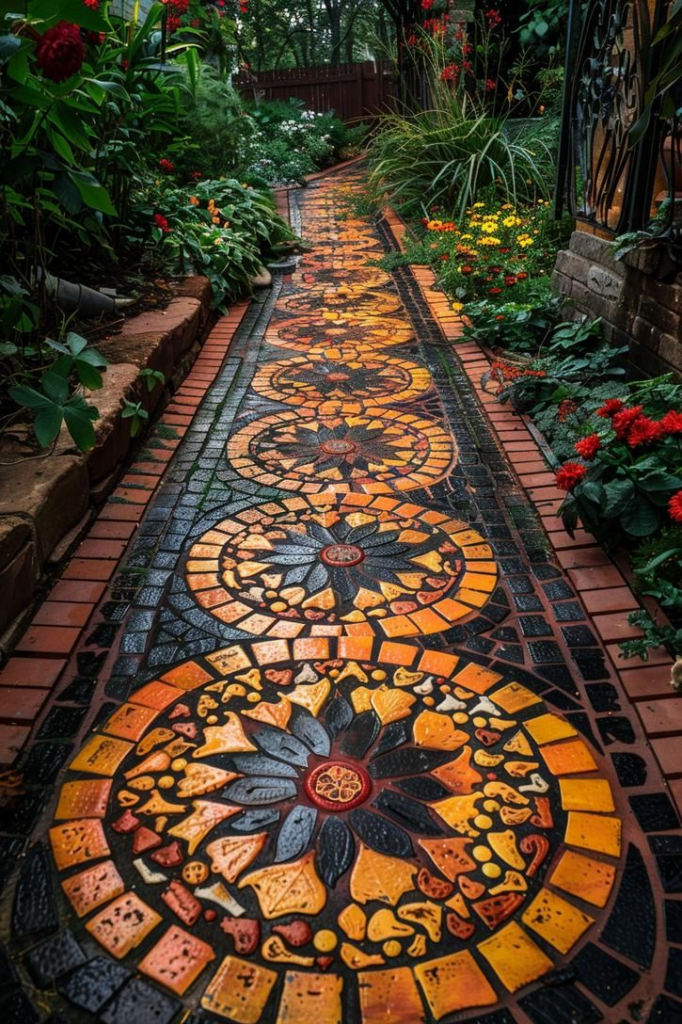
Detailed artistry can instantly refine the look of any outdoor walkway. Mosaic tile accent inserts offer a personalized touch, blending colorful patterns into otherwise uniform paths. Whether installed between large pavers or along central walkways, these intricate designs introduce visual interest and highlight specific sections without overwhelming the overall layout.
Durable materials such as porcelain, glass, and natural stone withstand outdoor conditions, ensuring longevity despite exposure to fluctuating temperatures and moisture. Grouting with weather-resistant compounds prevents cracking and water penetration, preserving the integrity of the design over time. Positioning mosaic accents at key transition points or entryways brings focus to high-traffic areas while allowing creativity to flourish.
In terms of upkeep, regular sealing helps maintain vibrant colors and shields the surface from stains caused by dirt or organic debris. Gentle cleaning with non-abrasive solutions safeguards the finish, preventing dullness from developing after prolonged use.
For DIY enthusiasts, pre-assembled mosaic sheets simplify the installation process, reducing layout time and ensuring precise alignment. These accents serve both functional and decorative purposes, seamlessly integrating artistry into daily paths. When executed thoughtfully, mosaic tile inserts become enduring features that elevate the walkway’s character and reflect the homeowner’s unique style sensibilities.
Rolling Gravel Refill Trays

Maintaining pristine gravel walkways can become tedious without an efficient system. Rolling gravel refill trays solve this issue by enabling quick replenishment, keeping pathways level and well-covered without the hassle of manual spreading. These low-profile trays sit beneath the surface, designed to glide smoothly as gravel shifts with foot traffic, automatically evening out displaced areas.
Selecting heavy-duty materials like galvanized steel or reinforced plastic ensures durability against constant use and varying weather. Trays should feature perforated bottoms to promote proper drainage, preventing water buildup and subsequent erosion. Installing them during initial pathway construction allows seamless integration, minimizing disruption to the surrounding landscape.
Routine checks guarantee optimal performance. Clearing accumulated debris from the tray tracks maintains free movement, and topping up gravel as needed ensures consistent coverage. Over time, this system reduces the need for labor-intensive raking, making it ideal for expansive walkways or areas with frequent use.
By simplifying maintenance while preserving the walkway’s appearance, rolling gravel refill trays provide a practical solution for homeowners seeking effortless upkeep. Beyond functionality, they contribute to the overall aesthetic by ensuring smooth, even surfaces, offering long-term benefits to outdoor spaces designed for both beauty and durability.
Layered Wood Slice Steps
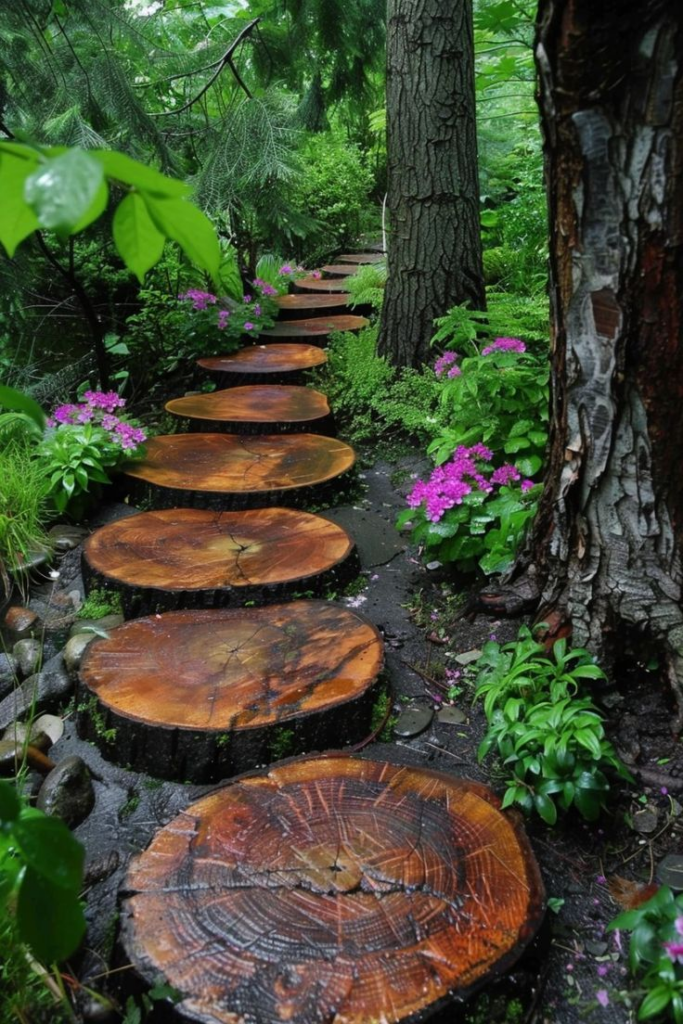
Natural textures remain a timeless choice for garden paths, and layered wood slice steps bring warmth and rustic charm to outdoor walkways. By stacking cross-sections of durable hardwood like oak or cedar, these steps form a sturdy, organic path that visually contrasts surrounding greenery while providing reliable footing.
Preparing the site is crucial to ensure stability. Begin with a compacted gravel base to support drainage and minimize shifting. Arranging slices in staggered layers adds depth, while securing each piece with landscape spikes prevents movement over time. To extend longevity, treating the wood with weather-resistant sealants protects against moisture, insects, and decay.
Seasonal upkeep involves inspecting slices for signs of rot or splitting. Replacing compromised sections quickly maintains both safety and aesthetics. Regular sweeping clears away organic debris, preventing moss buildup that could create slippery conditions.
Pairing wood slice steps with soft ground covers like moss or creeping thyme enhances the path’s natural appeal while filling gaps between layers. This approach balances structure with organic beauty, making the walkway feel like an intentional extension of the landscape.
For those seeking an eco-friendly, distinctive alternative to conventional pavers, layered wood slice steps provide a creative, sustainable option rooted in nature’s charm.
Solar-Powered Glass Pebble Rows
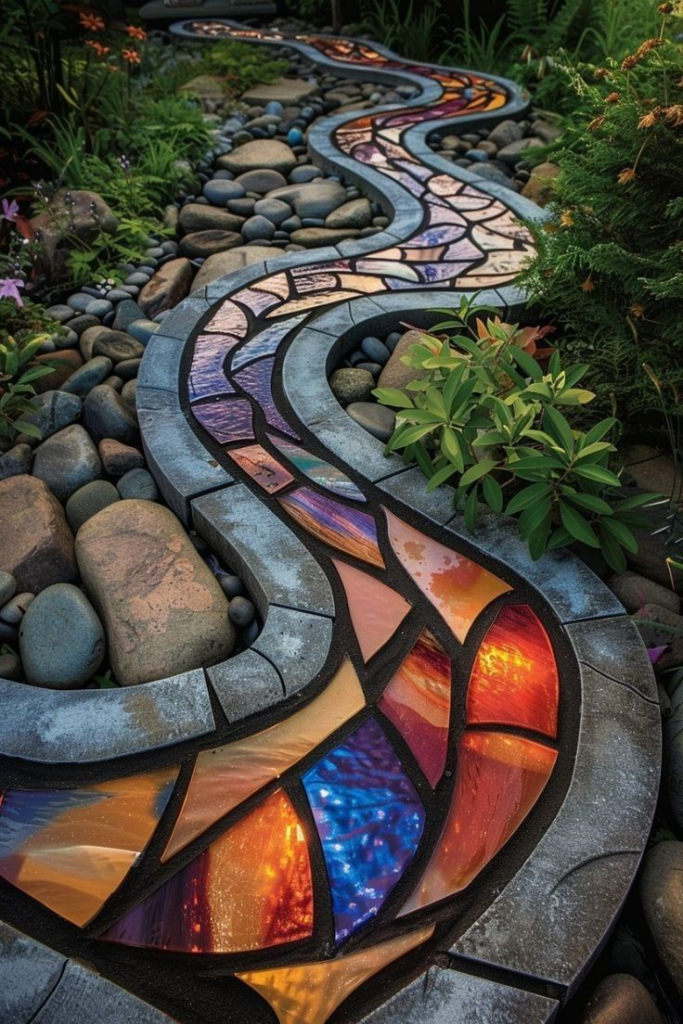
Illuminating outdoor walkways without complex wiring is achievable through solar-powered glass pebble rows. These glowing accents absorb sunlight during the day, storing energy to cast a soft, ambient light across the path once evening falls. Their translucent design, available in various colors and finishes, blends easily into gravel, stone, or sand pathways while providing subtle nighttime visibility.
Strategic placement is key for consistent charging. Position the pebbles in areas that receive direct sunlight for several hours, avoiding shaded spots where energy collection may be compromised. Spacing them evenly throughout the walkway ensures a uniform glow and helps define borders after dark.
Maintenance is minimal, requiring occasional wiping to clear dust or debris from the surface, allowing maximum light absorption. During winter months, storing the pebbles indoors extends their lifespan if harsh conditions threaten their integrity.
Beyond practical safety, these solar accents contribute to the overall ambiance of the outdoor space. Their gentle illumination enhances evening gatherings and adds an enchanting, modern aesthetic without increasing electricity costs. Whether framing entire paths or emphasizing specific sections, solar-powered glass pebble rows provide an energy-efficient solution that effortlessly combines beauty with functional lighting for outdoor walkways.
Fold-Out Privacy Side Screens

Outdoor walkways benefit from elements that enhance both privacy and design. Fold-out side screens offer an effective solution for shielding paths from neighboring views while adding architectural interest. These hinged panels, typically crafted from treated wood, metal, or composite materials, can be expanded or folded back as needed, allowing versatility depending on the occasion or season.
Securing the screens with weather-resistant hardware ensures they remain stable, even in areas prone to wind. Installing them along one or both sides of a walkway provides defined boundaries, creating a more intimate atmosphere without completely enclosing the space.
To complement the natural surroundings, consider screens featuring decorative cutouts, latticework, or trellis attachments to support climbing plants. This creates a living wall effect, offering additional texture and greenery over time.
Care involves periodic cleaning and treating surfaces to resist moisture and UV exposure, preserving both function and appearance. Hinges should also be checked regularly for smooth operation.
For those seeking adjustable privacy that doesn’t sacrifice style, fold-out side screens bring flexibility to garden paths and backyard walkways. Their practical design ensures comfort and seclusion while contributing visual depth and structure to outdoor environments.
Mixed Material Braided Paths

Creative use of varied textures can result in truly distinctive outdoor walkways. Mixed material braided paths weave together contrasting elements like stone, wood, and gravel in interlacing patterns that provide both visual intrigue and durable footing. This approach allows homeowners to customize paths that echo surrounding landscapes while breaking away from traditional, single-material designs.
Layout precision ensures a harmonious blend. Start by outlining the desired shape and dividing sections into repeating loops or waves where each material flows into the next. For example, slate can trace the outer curves while wooden planks or bricks fill inner segments, with gravel interspersed to soften transitions.
Durability depends on properly preparing the base layer. A compacted foundation prevents uneven settling and helps materials stay aligned over time. Regular inspections identify areas where infill needs replenishment or adjustments are required to maintain balance.
Beyond aesthetic appeal, braided paths reduce monotony and create natural segmentation, guiding visitors through distinct garden zones. With thoughtful selection and placement, these walkways offer enduring beauty that evolves as the materials weather naturally, adding depth and character. This method suits those wanting a path that functions as both a thoroughfare and a work of art within the landscape.
Lift-Up Maintenance Paver Panels

Accessible design plays a critical role in creating functional outdoor spaces, and lift-up maintenance paver panels provide a smart solution for concealed access beneath walkways. These removable sections blend seamlessly with surrounding paving while allowing easy entry to utility lines, irrigation systems, or drainage channels without disturbing the overall structure.
Selecting high-strength, reinforced materials like concrete or stone ensures durability, especially in high-traffic areas. For smoother handling, integrating discreet lifting points or handles beneath the surface keeps the appearance cohesive while making removal manageable. Precise installation is essential, with a stable sub-base that prevents shifting and guarantees that panels realign properly after servicing.
Regular monitoring keeps the mechanism functioning optimally. Clearing debris from the seams avoids sticking, while lubricating any integrated hinges or locking systems prolongs usability. Additionally, inspecting the underlying access areas periodically prevents small issues from escalating.
By providing a practical balance between form and function, lift-up maintenance paver panels streamline upkeep without sacrificing design integrity. This feature is particularly valuable in larger landscapes where hidden infrastructure requires routine checks. Thoughtful placement ensures both convenience and visual continuity, making these panels a go-to solution for homeowners seeking discreet utility access within stylish walkway designs.
Hinged Herb Border Walkways

Integrating edible landscaping into garden paths can enhance both appearance and practicality. Hinged herb border walkways feature raised beds or built-in planters along the sides of paths, with panels that swing open for easy tending and harvesting. This dual-purpose design maximizes space while allowing seamless movement through lush, aromatic corridors.
Sturdy frames made from weather-resistant materials like cedar or powder-coated metal ensure durability across seasons. Hinges should be rust-resistant to withstand outdoor conditions and operate smoothly over time. Spacing the beds appropriately along the path allows for healthy plant growth without encroaching on foot traffic.
To simplify maintenance, consider installing drip irrigation within the borders to provide consistent watering while minimizing runoff onto the walkway. Periodic pruning and soil refreshing keep herbs thriving and accessible. Choosing a variety of plants—such as thyme, lavender, rosemary, and oregano—adds color, fragrance, and culinary benefits, making the path both beautiful and functional.
Beyond the practical aspects, these hinged herb borders offer a sensory experience with every step. They define the walkway while transforming it into an interactive, productive part of the landscape. For those seeking versatility and charm, this design merges gardening with graceful, intentional movement through outdoor spaces.
Floating Concrete Slab Illusions

Visually striking walkways often rely on clever design techniques, and floating concrete slab illusions create the impression of suspended steps hovering just above the ground. By installing individual slabs with subtle gaps between them and slightly raising each one over a recessed base, the path achieves a weightless, modern aesthetic while maintaining full structural integrity.
For successful execution, precise leveling is essential. Supporting each slab on discreet pedestals or compacted gravel pads keeps them elevated while allowing water drainage beneath the surface to prevent pooling and erosion. Opting for textured or brushed finishes on the slabs helps increase traction, ensuring safety during wet conditions.
Lighting plays a key role in enhancing the floating effect. Low-profile ground lights or embedded LED strips can outline the underside of each step, casting soft shadows that heighten the visual separation. Routine upkeep involves checking for settling or shifts in the supports and cleaning surfaces to remove dirt that may dull the effect.
This style works well in minimalist landscapes and contemporary settings, offering a bold focal point that guides the eye while blending seamlessly into its surroundings. Floating concrete slab illusions combine durability with a sense of artistry, redefining what a simple garden path can achieve.
Curved Mirror Wall Endpoints

Defining the conclusion of a walkway with visual flair is achievable through the use of curved mirror wall endpoints. These reflective installations extend the perception of space, giving paths the illusion of greater length while introducing a dynamic element that captures light and surrounding scenery. Gentle curves soften the appearance, preventing harsh lines and creating a more organic flow in outdoor environments.
Selecting shatter-resistant, outdoor-rated mirror panels ensures durability against weather exposure. Mounting them securely on reinforced frames, ideally anchored into the ground, prevents shifting while providing structural support over time. To maximize the reflective effect, placing mirrors at angles that capture both natural greenery and open sky enhances depth and makes narrow spaces appear wider.
Cleaning mirrors regularly helps maintain clarity, while treating the surface with anti-fog or water-repellent coatings reduces streaking after rain. Adding small planting beds or decorative stones around the mirror’s base further integrates the feature into the landscape.
Beyond aesthetics, curved mirror wall endpoints provide a sense of intrigue as they reflect unexpected perspectives. Their ability to balance structure and illusion makes them an inventive addition, bringing unexpected dimension to walkways while subtly enhancing privacy and framing outdoor scenes.
Portable Boardwalk Panels

Temporary pathways often require flexible solutions, and portable boardwalk panels provide a practical way to create sturdy, movable walkways that can adapt to changing outdoor layouts. These panels, typically constructed from treated wood or composite materials, are designed to connect securely while allowing for easy relocation or storage as needed.
Choosing materials with high weather resistance ensures durability through various seasons, while non-slip finishes add safety in damp or muddy conditions. Modular design allows sections to snap together, forming custom lengths or curves that suit both compact garden spaces and expansive yards. Ground preparation is minimal—simply clearing debris and leveling the area offers sufficient support for temporary use.
Periodic inspections keep panels in top condition. Checking for loose fasteners, warped boards, or worn connectors helps prevent structural issues. Between uses, storing panels in a dry, sheltered location extends their lifespan and reduces the risk of mildew or rot.
Beyond their practical benefits, portable boardwalk panels contribute to a cohesive outdoor aesthetic. Whether leading through a wildflower garden or providing access across softer soil, these adaptable pathways strike a balance between convenience and style, offering homeowners the freedom to redefine their landscapes while ensuring safe and comfortable footing.
Rustic Log Side Railings

Defined edges can transform a simple walkway into a standout feature, and rustic log side railings bring both structure and charm to garden paths. Crafted from natural logs, these railings not only delineate the path but also introduce a rugged, organic element that blends seamlessly with wooded or rural landscapes.
Selecting rot-resistant wood species, such as cedar or locust, ensures lasting durability in outdoor environments. For installation, anchoring logs into gravel-packed post holes stabilizes the structure while promoting drainage. Staggering the height and spacing of the rails provides visual interest and prevents the walkway from feeling overly uniform.
Preserving the logs with clear, outdoor-rated sealants protects them from moisture and insect damage while maintaining their natural texture. Occasional cleaning and inspection for cracks or splitting keep the railings looking their best and functioning safely.
Integrating climbing vines or flowering plants alongside the rails softens the overall appearance, allowing greenery to weave through the structure over time. Beyond their visual appeal, rustic log side railings offer subtle guidance along the path, enhancing both safety and aesthetics. This approach complements walkways seeking a balance of raw beauty and purposeful design, making nature itself a key element of the journey.
Water-Channel Border Walkways
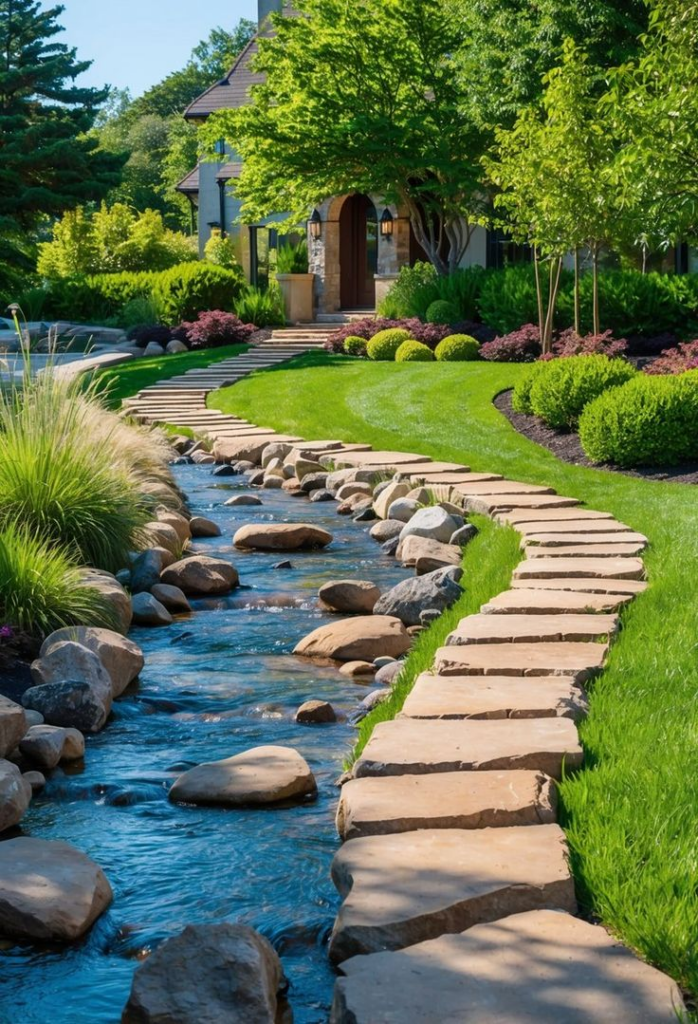
Integrating gentle water features alongside a garden path adds both tranquility and motion to outdoor spaces, and water-channel border walkways achieve this by incorporating narrow streams or runnels along the edges of the walkway. These shallow channels guide a continuous flow of water, creating a soothing auditory backdrop while naturally framing the path with a dynamic visual element.
Durable materials like stone, concrete, or metal liners help define the channels and withstand year-round weather conditions. Precision leveling is essential to maintain an even flow without pooling, and discreet pumps recirculate water to minimize waste. To ensure the system runs smoothly, regular maintenance includes clearing debris, checking water levels, and cleaning filters, especially during leaf-heavy seasons.
Planting low-profile greenery or moss along the outer edges of the channels softens the hardscape and introduces more natural textures, making the water appear as though it belongs organically to the landscape. At night, low-voltage underwater lights can highlight the gentle movement of the stream, extending the walkway’s appeal into evening hours.
Water-channel border walkways provide more than just aesthetics. They offer a multi-sensory experience, transforming an ordinary stroll into a peaceful, immersive journey that marries the elements of sound, sight, and movement in perfect harmony.
